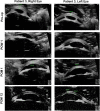Selective endothelial removal: A case series of a phase I/II surgical trial with long-term follow up
- PMID: 35966874
- PMCID: PMC9372295
- DOI: 10.3389/fmed.2022.901187
Selective endothelial removal: A case series of a phase I/II surgical trial with long-term follow up
Abstract
Peters anomaly is a congenital condition which results in a central corneal opacity from birth. Selective Endothelial Removal (SER) is a novel surgical technique and a form of regenerative therapy, which encourages clearance of the central corneal opacity by the patient's own corneal endothelial cells, and it may potentially be beneficial for the treatment of Peters anomaly. We have performed a phase I/II surgical trial, evaluating the safety of SER in four eyes (three patients) with Peters Anomaly. These patients underwent SER at between 9 and 39 months of age, each demonstrating clearance of central corneal opacities and improvements in vision post-operatively. No complications occurred in any of these eyes, at a minimal post-operative follow-up duration of 48 months. We conclude that SER for Peters anomaly is a safe surgical procedure. While encouraging efficacy outcomes have been observed, these findings should be further evaluated in a larger scale Phase II/III surgical trial.
Keywords: Peters anomaly; cornea; endothelium; keratoplasty; regenerative medicine.
Copyright © 2022 Liu, Soh, Kocaba and Mehta.
Conflict of interest statement
The authors declare that the research was conducted in the absence of any commercial or financial relationships that could be construed as a potential conflict of interest.
Figures




Similar articles
-
Long-term results of corneal graft survival in infants and children with peters anomaly.Ophthalmology. 1999 Apr;106(4):833-48. doi: 10.1016/S0161-6420(99)90175-6. Ophthalmology. 1999. PMID: 10201611
-
Selective Endothelial Removal for Peters Anomaly.Cornea. 2018 Mar;37(3):382-385. doi: 10.1097/ICO.0000000000001472. Cornea. 2018. PMID: 29408830 Review.
-
Peters Anomaly.2023 Aug 25. In: StatPearls [Internet]. Treasure Island (FL): StatPearls Publishing; 2025 Jan–. 2023 Aug 25. In: StatPearls [Internet]. Treasure Island (FL): StatPearls Publishing; 2025 Jan–. PMID: 35593847 Free Books & Documents.
-
Keratolenticular adhesion removal for type 2 Peters anomaly: a case report.Eye Vis (Lond). 2020 Jul 15;7:39. doi: 10.1186/s40662-020-00203-5. eCollection 2020. Eye Vis (Lond). 2020. PMID: 32676510 Free PMC article.
-
A novel histopathologic finding in the Descemet's membrane of a patient with Peters Anomaly: a case-report and literature review.BMC Ophthalmol. 2015 Oct 23;15:139. doi: 10.1186/s12886-015-0131-y. BMC Ophthalmol. 2015. PMID: 26496717 Free PMC article. Review.
Cited by
-
Congenital anterior segment ocular disorders: Genotype-phenotype correlations and emerging novel mechanisms.Prog Retin Eye Res. 2024 Sep;102:101288. doi: 10.1016/j.preteyeres.2024.101288. Epub 2024 Aug 2. Prog Retin Eye Res. 2024. PMID: 39097141 Review.
-
Quantitative analysis of intraocular pressure and clinical-morphometric characteristics in Peters' anomaly: a single-center study.Front Med (Lausanne). 2025 Jun 26;12:1520706. doi: 10.3389/fmed.2025.1520706. eCollection 2025. Front Med (Lausanne). 2025. PMID: 40641960 Free PMC article.
-
Keratoplasty: are children missing out on the lamellar revolution-the 2023 Bowman Club, David L. Easty Lecture.BMJ Open Ophthalmol. 2024 Oct 24;9(1):e001804. doi: 10.1136/bmjophth-2024-001804. BMJ Open Ophthalmol. 2024. PMID: 39455068 Free PMC article.
References
LinkOut - more resources
Full Text Sources

